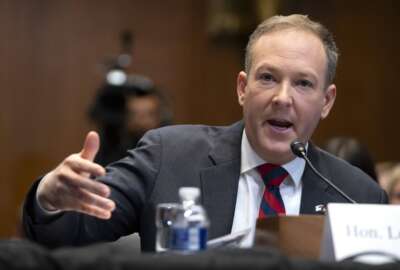GAO: Not too early to track DATA Act progress
The Government Accountability Office is taking an early interest in how the White House and Treasury Department draft government-wide financial data standards, due...
At an event on the power of data analytics, speakers talked about its potential to solve some of government’s toughest challenges: stopping $150 billion in improper payments a year, collecting lost tax revenue, getting the Defense Department ready for its first full audit in 2017 and improving federal IT procurement by identifying bottlenecks in programs. The opportunities seem limitless.
But Comptroller General Gene Dodaro, who heads the Government Accountability Office, came to the conference, hosted by Government Executive Media Group, to burst their bubble.
“If the data quality is not good, you’re limited in your abilities to use it,” he said.
That’s the case in the federal government all too often, GAO auditors have found. Whether it’s identifying overlapping teacher-training programs or tracking federal grants, auditors find they cannot compare apples to apples because agencies use different terms and methods to define their data. One agency might call award recipients “grantees,” while another might say they’re “grant recipients.” When auditors cannot trust agencies’ data, they end up doing much of the legwork themselves, Dodaro said.
“In many cases, it takes us a lot of time and effort to assure ourselves of the quality of the data when, in my belief, it should be assured by the executive departments and agencies as a routine manner as a management responsibility,” he said.
That’s why GAO is taking an early interest in how the Treasury Department and Office of Management and Budget hammer out the first government-wide financial data standards. Under a new law, called the DATA Act, they must publish those standards by next summer. Congress has directed GAO to evaluate the government’s implementation of the law in 2017, but Dodaro said he is not waiting until then.
“I want us to be involved early. I want us to track the development of the standards to make sure that the standards will be complete and accurate and will provide the proper underpinning,” he said. “I don’t want to come in a year or two later to say we don’t think the standards were developed properly.”
He has a briefing with Treasury and OMB officials scheduled for later this month.
Dodaro said he’s hopeful that OMB will address other, long-standing problems with government data as it drafts the new standards. For example, in evaluating USASpending.gov, a public database of federal awards, GAO found that only 2 to 7 percent of the data in the web portal was consistent with the agency records which were supposedly the sources of that data.
Auditors recommended that OMB clarify its guidance to agencies on tracking award information, and while the agency agreed with the recommendations, it has held off on making changes. It wants to do that concurrently with implementing the DATA Act, Dodaro said. OMB also pledged to do a better job of creating an inventory of all federal programs. Early efforts largely have failed because OMB left it up to agencies to decide what constitutes a program.
Moving ahead with data analytics
But like other agencies, GAO is developing its own systems to analyze the mountains of data at its disposal. Dodaro sees it as a financial imperative. GAO lost about a sixth of its workforce between 2010 and 2013, as it struggled with budget constraints and sequestration. While it has added back some staff, “the cavalry is not going to arrive with fresh troops” in the near future, Dodaro said.
Under Chief Scientist Tim Persons and Acting Director Vijay D’Souza, GAO is building a data-mining strategy. Dodaro sees promise for the applications in GAO’s efforts to prevent and track improper payments, identify fraud and find trouble spots when evaluating federal programs. While a number of concepts are in the pilot stage, he said, “we’re achieving good success.”
“At GAO, we have access to a lot of information that others don’t have access to, so I want to make sure we’re fully using that,” he said.
RELATED STORIES:
Inside the Reporter’s Notebook: DATA Act is law, IT, acquisition A-11 changes
Treasury’s fixes to USASpending.gov begin with mapping, navigation
Recipe for a successful DATA Act is part collaboration, part oversight
Copyright © 2025 Federal News Network. All rights reserved. This website is not intended for users located within the European Economic Area.





